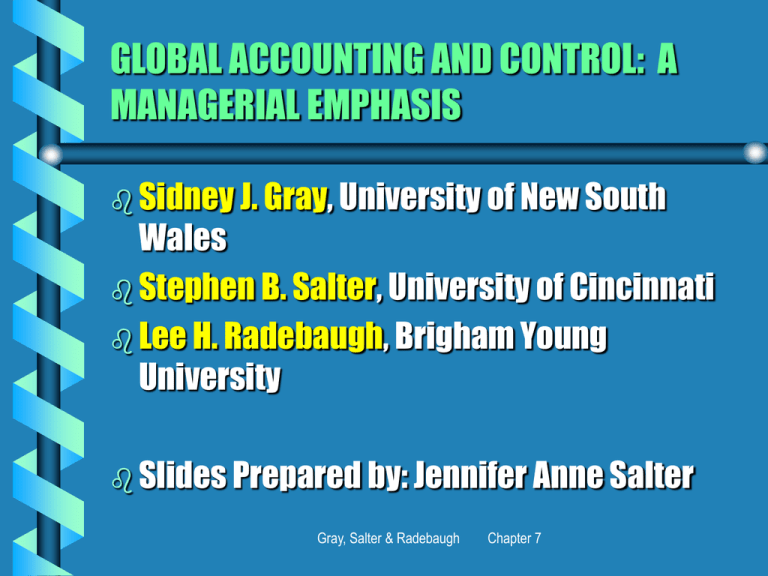
GLOBAL ACCOUNTING AND CONTROL: A
MANAGERIAL EMPHASIS
Sidney J. Gray, University of New South
Wales
Stephen B. Salter, University of Cincinnati
Lee H. Radebaugh, Brigham Young
University
Slides Prepared by: Jennifer Anne Salter
Gray, Salter & Radebaugh
Chapter 7
CHAPTER SEVEN
GLOBAL FINANCIAL STATEMENT ANALYSIS
Gray, Salter & Radebaugh
Chapter 7
INTRODUCTION
A management approach to global
financial statement analysis.
Take information from accounting systems
to allow managers to meet strategies.
Gray, Salter & Radebaugh
Chapter 7
ENVIRONMENTAL INFLUENCES ON
FINANCIAL REPORTING
Influences on financial reporting and
information disclosure practices:
•
•
•
•
•
Enterprise ownership;
Activities of enterprises;
Sources of finance;
Taxation;
Level of development & independence of the
auditing and financial reporting profession;
Gray, Salter & Radebaugh
Chapter 7
ENVIRONMENTAL INFLUENCES ON
FINANCIAL REPORTING - Table 7.2
Gray, Salter & Radebaugh
Chapter 7
ENVIRONMENTAL INFLUENCES ON
FINANCIAL REPORTING Cont’d
•
•
•
•
Stage of economic growth & development;
Legal system;
Influence of culture;
International factors.
Gray, Salter & Radebaugh
Chapter 7
CLASSIFICATION OF FINANCIAL
REPORTING SYSTEMS (FRPs)
There have been many attempts to classify
and explain why countries differ in their
financial reporting practices.
Two models with difference perspectives
are:
• Nobes (1983)
• Gray (1988)
Gray, Salter & Radebaugh
Chapter 7
CLASSIFICATION OF FRS:
The Nobes (1983) Model
Two basic classes of financial reporting
systems:
• Microeconomic (business oriented)system
where key determinants are:
– basic philosophy; historical origin
• Macroeconomic (government oriented)
system:
– taxation; economic management.
Gray, Salter & Radebaugh
Chapter 7
CLASSIFICATION OF FRS:
The Nobes (1983) Model
Gray, Salter & Radebaugh
Chapter 7
CLASSIFICATION OF FRS:
The Gray (1988) Model
A more comprehensive model based on
Hofstede’s (1980) cultural dimensions and
the institutions that arise from them.
Gray’s model has been empirically tested
by Salter & Niswander (1995)
Gray, Salter & Radebaugh
Chapter 7
CLASSIFICATION OF FRS:
The Gray (1988) Model
Drawing on the work of Gray (1988) and
Nobes (1983), two key parameters which
define financial reporting systems are:
• How systems are determined and enforced:
– statutory control or professional means.
• The measurement and disclosure
characteristics of financial reporting systems.
Gray, Salter & Radebaugh
Chapter 7
CLASSIFICATION OF FRS: Gray (1988)
Accounting Cultural Values
Gray, Salter & Radebaugh
Chapter 7
CLASSIFICATION OF FRS:
Gray’s (1988) Dimensions
Gray, Salter & Radebaugh
Chapter 7
CLASSIFICATION OF FRS:
Gray’s (1988) Country CLassifications
Gray, Salter & Radebaugh
Chapter 7
CLASSIFICATION OF FRS:
Gray’s (1988) Country Classifications
Gray, Salter & Radebaugh
Chapter 7
CLASSIFICATION OF FRS:
Salter & Niswander (1995) and Gray
(1988)
Integrating these two works we find:
• Individualist societies (UK, USA) demand:
– more disclosure,
– a stronger independent audit profession to ensure
rights of individual investor.
• High uncertainty avoidant societies (Japan,
Germany) demand:
– uniform accounting rules passing through the legal
system.
Gray, Salter & Radebaugh
Chapter 7
CLASSIFICATION OF FRS:
Salter & Niswander (1995) and Gray
(1988)
Salter & Niswander add that:
• Development of financial markets enhances
power of auditors, encourages increased
disclosure and a more optimistic view of
income.
• Higher tax rates reduce income and relative
power of auditors.
Gray, Salter & Radebaugh
Chapter 7
CLASSIFICATION OF FRS:
Salter & Niswander (1995) and Gray
(1988)
Gray, Salter & Radebaugh
Chapter 7
MAJOR DIFFERENCES IN FINANCIAL
REPORTING
Financial reporting issues that separate
countries are:
• Format
• Measurement
• Disclosure
Gray, Salter & Radebaugh
Chapter 7
MAJOR DIFFERENCES IN FINANCIAL
REPORTING - Format
Format includes statements used and what
they contain.
Most countries have statements about
income/expenses and assets/liabilities.
Less common are: statements of cash
flows, changes in financial position, and
retained earnings.
Gray, Salter & Radebaugh
Chapter 7
MAJOR DIFFERENCES IN FINANCIAL
REPORTING - Measurement
Major areas of diversity are:
•
•
•
•
•
•
•
depreciation
inventory measurement
retirement benefits
construction contracts
research and development
accounting for taxation
business combinations
Gray, Salter & Radebaugh
Chapter 7
THE IMPACT OF ACCOUNTING
DIFFERENCES
The subtleties of different sets of
measurement rules can be seen by using
Gray’s (1980) index of conservatism:
• Conservatism is the extend to which, given the
same basic accounting data, 2 companies
would arrive at earnings numbers that are
higher or lower.
Gray, Salter & Radebaugh
Chapter 7
THE IMPACT OF ACCOUNTING
DIFFERENCES - Index of Conservatism
Gray (1980) uses the following formula to
measure relative conservatism:
• Index of Conservatism = 1 - (RA - RD) / I RA I
where:
° RA = adjusted earnings under the GAAP of the
country being used as a standard
° RD = disclosed earnings under the national GAAP of
the country whose conservatism is being assessed.
Gray, Salter & Radebaugh
Chapter 7
THE IMPACT OF ACCOUNTING
DIFFERENCES - Index of Conservatism
° I RA I = the absolute value of adjusted earnings
under the GAAP of the country being used as the
standard.
• Using the US as the base, and comparing US
versus UK accounting principles, the formula
can be translated as follows
– Index of Conservatism = 1 - (US GAAP Earnings - UK
GAAP Earnings) / I US GAAP Earnings I
Gray, Salter & Radebaugh
Chapter 7
THE IMPACT OF ACCOUNTING
DIFFERENCES - Index of Conservatism
An Index value greater than 1 means that UK
GAAP earnings are less “conservative”
(more optimistic) than a US GAAP.
Gray, Salter & Radebaugh
Chapter 7
THE IMPACT OF ACCOUNTING
DIFFERENCES - Index of Conservatism
Having established an overall index of
conservatism, it is then possible to
establish the relative effect of the various
individual adjustments by constructing a
partial index of “conservatism” using the
formula:
• 1 - (partial adjustment / US GAAP Earnings)
Gray, Salter & Radebaugh
Chapter 7
THE IMPACT OF ACCOUNTING
DIFFERENCES - Conservatism and the
SEC Form 20F
Form 20F allows an opportunity to compare
earnings resulting from any country’s
accounting principles with those that
would have resulted under US accounting
principles.
• Form 20F report to the SEC contains a
reconciliation of foreign earnings with the
earnings that would have reported under US
GAAP
Gray, Salter & Radebaugh
Chapter 7
THE IMPACT OF ACCOUNTING
DIFFERENCES - Conservatism and the
SEC Form 20F
• Radebaugh and Gray (1997) have drawn up
indices of conservatism for 8 countries
• Continental European countries and Japan are
more conservative than the US.
Gray, Salter & Radebaugh
Chapter 7
Conservatism and the SEC Form 20F Figure 7.5
Gray, Salter & Radebaugh
Chapter 7
GLOBAL HARMONIZATION
While many organizations (UN, EU) have
been concerned with harmonizing
international differences in accounting
and reporting, the most important body is
the International Accounting Standards
Committee (IASC).
Gray, Salter & Radebaugh
Chapter 7
GLOBAL HARMONIZATION Cont’d
The main aim of the IASC has been to
achieve a degree of comparability that will
help investors make their decisions while
reducing the costs of MNEs in preparing
multiple sets of accounts and reports.
Gray, Salter & Radebaugh
Chapter 7
Copyright
Copyright 2001 John Wiley & Sons, Inc. All rights reserved.
Reproduction or translation of this work beyond that
permitted in Section 117 of the 1976 United States Copyright
Act without the express written permission of the copyright
owner is unlawful. Request for further information should be
addressed to the Permissions Department, John Wiley &
Sons, Inc. The purchaser may make backup copies for
his/her own use only and not for distribution or resale. The
Publisher assumes no responsibility for errors, omissions,
or damages, caused by the use of these programs or from
the use of the information contained herein.
Gray, Salter & Radebaugh
Chapter 7










